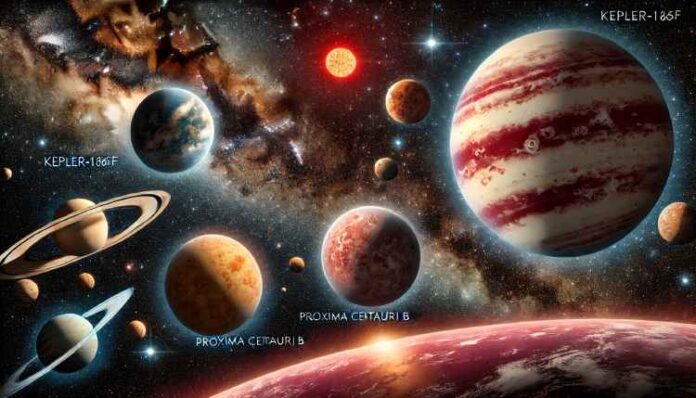The quest to discover Earth-like planets beyond our solar system has led to fascinating findings. Among the thousands of exoplanets discovered, Kepler-186f, Proxima Centauri b, and the planets of the TRAPPIST-1 system stand out as potential candidates for harboring life due to their position in the “habitable zone” of their respective stars. Here’s a closer look at these celestial neighbors, the teams who discovered them, and the technology that made it all possible.
Kepler-186f
- Discovery Date: April 17, 2014
- Discovering Team: NASA’s Ames Research Center team, led by Elisa V. Quintana, was responsible for the discovery.
- Telescope Used: NASA’s Kepler Space Telescope
- How it was discovered: The discovery of Kepler-186f was made using the transit method, where scientists detect tiny dips in the brightness of a star as a planet passes in front of it (called a “transit”). Kepler-186f orbits a star 500 light-years away in the constellation Cygnus.
- Significance: Kepler-186f is remarkable because it was the first planet of Earth-size to be found in the habitable zone of its star, meaning it could potentially have liquid water on its surface. The star it orbits is a cooler, dimmer M dwarf star. Though Kepler-186f is slightly larger than Earth, it’s unclear whether its atmosphere is conducive to life.
Proxima Centauri b
- Discovery Date: Announced on August 24, 2016
- Discovering Team: A team of astronomers led by Guillem Anglada-Escudé from Queen Mary University of London, working as part of the Pale Red Dot campaign.
- Telescope Used: The European Southern Observatory’s HARPS (High Accuracy Radial velocity Planet Searcher) spectrograph, along with other ground-based telescopes.
- How it was discovered: Proxima Centauri b was found using the radial velocity method, which measures the wobble of a star caused by the gravitational pull of an orbiting planet. The star’s light spectrum shifts due to the planet’s influence, allowing astronomers to infer the presence of the planet.
- Significance: Proxima Centauri b orbits Proxima Centauri, the closest star to our solar system at just 4.2 light-years away. It is within the habitable zone, meaning its temperature could allow for liquid water to exist, raising the possibility of life. However, because Proxima Centauri is a flare star, its solar activity might make the planet less hospitable than hoped.
TRAPPIST-1 System
- Discovery Date: The discovery of three planets was first announced in May 2016, and later in February 2017, NASA revealed that the system contained seven Earth-sized planets.
- Discovering Team: Led by Michaël Gillon of the University of Liège in Belgium, the discovery involved an international team of astronomers.
- Telescope Used: The TRAPPIST (Transiting Planets and Planetesimals Small Telescope) in Chile was initially used, followed by observations from NASA’s Spitzer Space Telescope and the European Southern Observatory’s telescopes.
- How it was discovered: The planets in the TRAPPIST-1 system were discovered using the transit method, similar to Kepler-186f. The planets cause slight dips in brightness as they pass in front of their star, a faint ultra-cool dwarf located 39.6 light-years away in the constellation Aquarius.
- Significance: What makes the TRAPPIST-1 system extraordinary is that seven Earth-sized planets orbit a single star, and three of them lie within the habitable zone where conditions might allow for liquid water. This makes the system one of the most promising places to search for extraterrestrial life. All seven planets are tightly packed, with orbital periods ranging from 1.5 to 13 days.
Conclusion: What’s Next in the Search for Life?
The discovery of planets like Kepler-186f, Proxima Centauri b, and those in the TRAPPIST-1 system provides tantalizing possibilities in our search for life beyond Earth. These worlds, located in the “Goldilocks” zone where conditions might be just right for life, are the focus of intense research as astronomers use ever-advancing technologies to explore their atmospheres, climates, and potential habitability.
With new telescopes like the James Webb Space Telescope already operational and others such as the Extremely Large Telescope in development, the future looks bright for uncovering the secrets of these distant worlds and answering one of humanity’s most profound questions: Are we alone in the universe?




